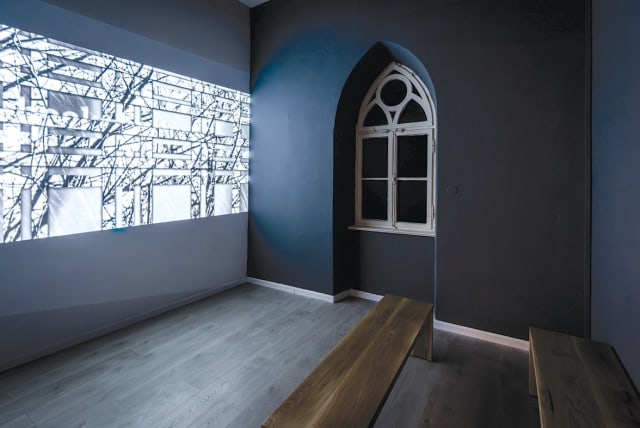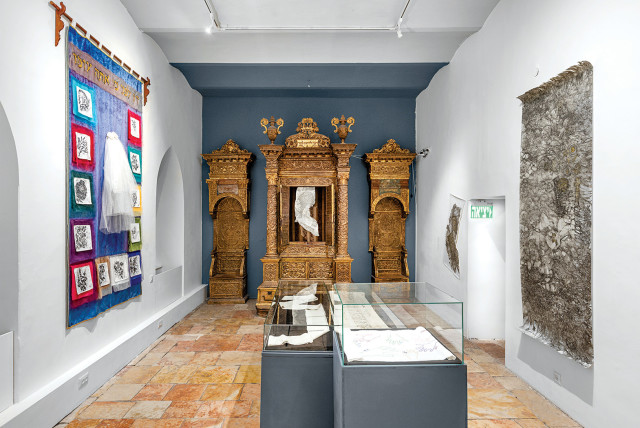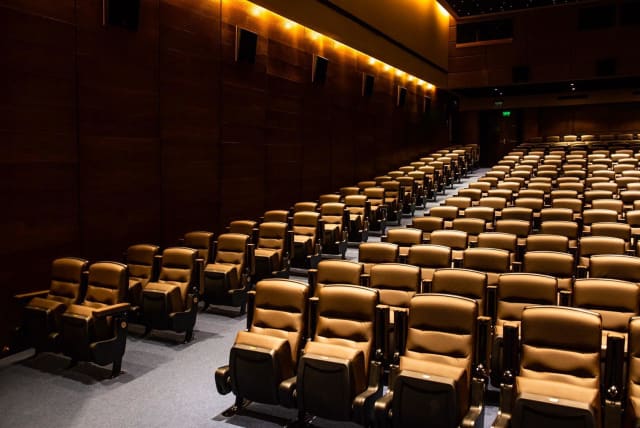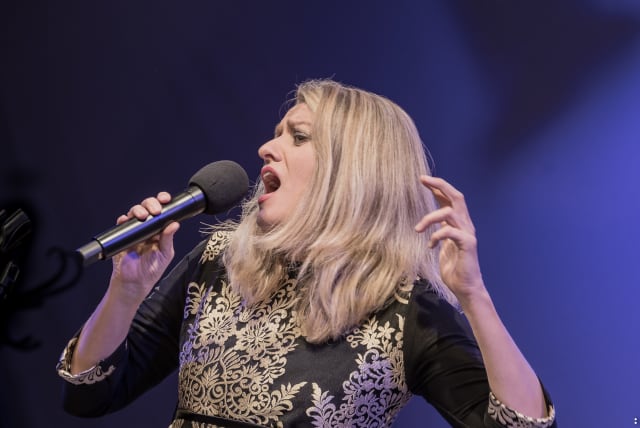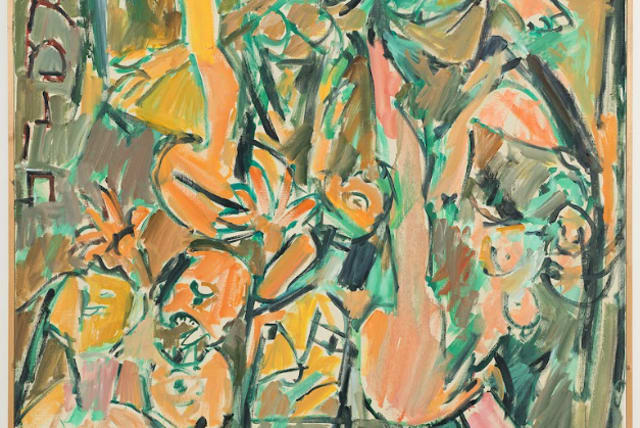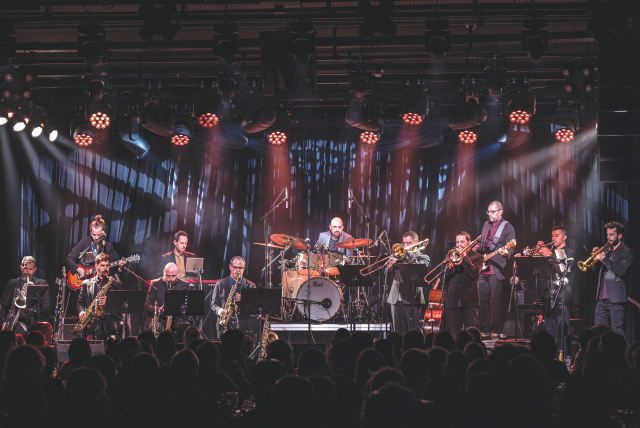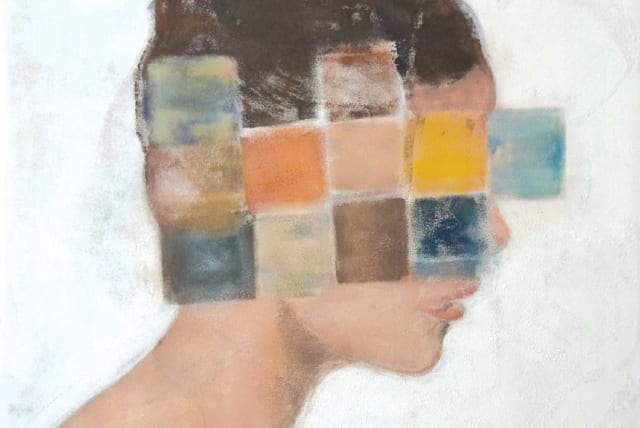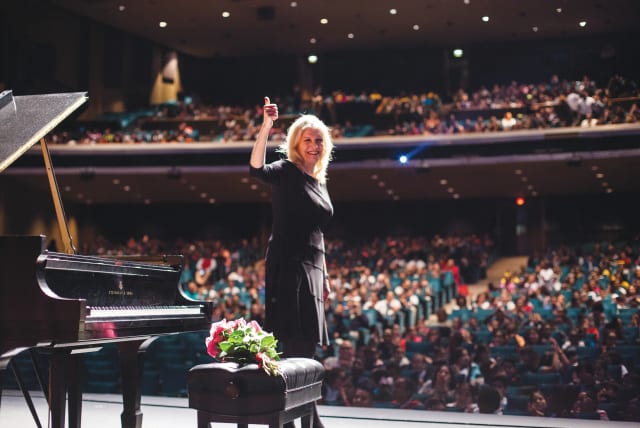
Despite the Israel-Hamas war, the popular Jerusalem Biennale is back, bigger and stronger than ever, in its sixth edition.
Pivoting from the intended October-November 2023 opening to Rosh Hodesh Adar II on March 10 must have been akin to turning a supertanker in mid-course. With more than 30 exhibitions spread over 20 Jerusalem venues, it was a huge logistical challenge.
The change was made “in the hope that this date will signal a turnaround for the better,” founding director Rami Ozeri says.
“We are absolutely committed to keeping Jerusalem on the international map of contemporary art.”
The celebratory kick-off took place at the U. Nahon Museum of Italian Jewish Art, in the first of two weeks of staggered exhibition openings. The unassuming courtyard on busy Hillel Street reveals its treasures upon entry.
What's on display at the Jerusalem Biennale?
In the interest of full disclosure, I am a participant in the exhibition “Threading,” curated by Emily D. Bilski, who wrote that the works of its seven contemporary artists are “in conversation with historical Judaica [from the museum’s collection], made and donated by women.” The Biennale website states that it also gives “voice to serious recognition of Jewish and Israeli women artists.”
The project initiator, Linda Lieff Altabef, conceived of an exhibition focusing on Jewish textiles. Her contribution is The Lifted Veil, a parochet (cover for a Torah Ark).
“The title comes from Victorian novelist George Eliot, who wrote under a male pseudonym and later revealed herself as female,” she explains. The parochet includes the artist’s wedding veil and botanical elements representing natural healing, woodcuts hand-printed on handkerchiefs. The artwork’s main phrase, “Know Before Whom You Stand,” is similar to the adjacent wooden Torah Ark, the oldest in the museum’s collection.
Mine is a personal item created from an heirloom textile, now around a century old, bearing the initial “H” for my Czech-born grandmother, Helene Just Breuer. Embroidering our hand contours, I repurposed it into a hand-washing towel for our Passover Seder, a sort of familial time capsule. This year will be different from all other years, as the towel will be on display, and not being used as intended.
THE EXHIBITION includes Andi Arnovitz’s What We Bring, celebrating Jewish women whose laser-cut names gush from her repurposed wedding dress. Detroit-based Lynne Avadenka’s Inventions, honoring trailblazing women who were Hebrew printers and publishers, forms mesmerizing circles inspired by antique Hebrew typeset. Raya Bruckenthal’s intricate graphite drawings respond to elements within the museum. And sculptor Rachel Tauber interprets feminine decorative textiles into wood and metal.
Internationally known video artist pioneer Beryl Korot’s film Etty weaves visual, textual, and stormy sound elements as its weft, warp, and diagonal threads, quoting the soon-to-be-murdered at Auschwitz young Dutch diarist Etty Hillesum (1914-1943). This presentation is Korot’s Israel debut.
The exhibition “Behind the Mask,” curated by Vera Pilpoul and Ermanno Tedeschi, shows artists from Israel and Italy who connect to The Book of Esther, including a Purim-themed work by rising star Shai Azoulay.
“Seeds of Memory” is curated by Elizabeta Zaidner. I was drawn to Nava T. Barazani’s intimate collages which consist of integrated drawings on paper scraps, evincing ephemeral childhood memories “poised to take flight and disappear,” says Zaidner in the wall text.
Berlin-based Israeli artist Mikhal Miki Gamzou displays works relating to the cyclamen flower, a life-long fascination for her. Printed over altered sacred texts, some of these flowers are contoured with burnt matchsticks as they varyingly represent loss and longing.
Visitors to “Doe of Dawn,” which opened at the Bible Lands Museum, were greeted by Queen Esther as portrayed by Canadian-Israeli Alana Ruben Free. Fans of video art and drawing should seek Maya Zack’s short film, an opportunity to see this master at work.
Visiting Jewish Art Salon members Yona Verwer, Siona Benjamin, Joan Roth, Ronit Levin Delgado, and others exhibited works in “Activate: A New York Women’s Perspective,” created abroad in response to October 7 and curated by Hadas Glazer at Koresh 14 Gallery. They were noticeably moved, facing Israel’s reality, with Verwer commenting at the opening how their hotel houses evacuees whose faces expose their worries. Ozeri remarked that coming to Jerusalem at this time was an “act of bravery.”
HIGHLIGHTS AT the Old Shaare Tzedek Hospital include “Stretch Out the Earth,” curated by Sophie Berzon MacKie, former curator of the Kibbutz Be’eri Gallery, where she first met photographer Noga Greenberg. Greenberg’s photographs of domestic moments are on display in the complex’s former synagogue with its restored painted ceiling.
“A Very Narrow Bridge,” curated by Fiammetta Martegani, includes Leonore Mizrahi’s Judeo-Arabic proverbs calligraphy works.
Raya Burckenthal’s A-Goldnae Gan Eden (Golden Paradise) 2021 video shown on a large screen follows a multi-layered creation originating in a 16th-century Yiddish text of Tzena U’Rena becoming gold Hebrew letters as if in an apocalyptic urban setting. A small-screen version is on view at the Museum on the Seam in the “Oryata” exhibition, curated by Dr. David Sperber, which shows 22 artists (echoing the 22 Hebrew letters) who “engage with the materiality of the [sacred] text itself by copying, overlaying, stamping, and blurring it,” he says. Many of the works are provocative, some dancing the line between sanctity and the profane.
Painting is alive and well if the exhibitions at the Van Leer Institute are any indication. Classically-trained Michal Rejwan presents “Dress Code,” curated by Avishay Wohl, displaying paintings depicting men in culturally influenced garb, some cross-dressed. It attracted the most eclectic crowd by far, while some of her sitters circulated dressed in what may have been raided from their mothers’ wardrobes.
A product of Jerusalem Studio School circles, Rejwan may find fellow alumni on the walls upstairs, where the exhibition “Nof-Nof-Nof” takes a broad view of the State of Israel landscape painting through the works of 23 multi-generational Israeli artists, curated by Nechemia Boaz and Victor Ryabchin.
Archie Rand presents his new series in his 40-year-long exploration of biblical texts, concentrating on women in “The Seventeen: Iron Flock,” curated by Samantha Baskind. They are depicted in high-keyed color palette mash-ups with comic book sensibility.■
The writer is a Jerusalem artist. Her memoir Life-Tumbled Shards was published in 2023. Reach her at heddyabramowitz@gmail.com


